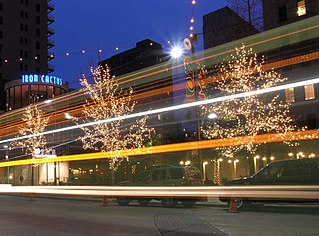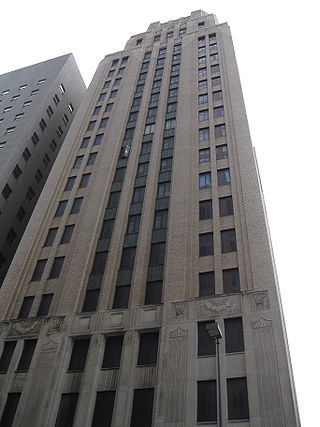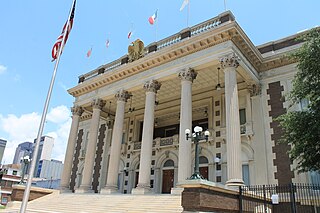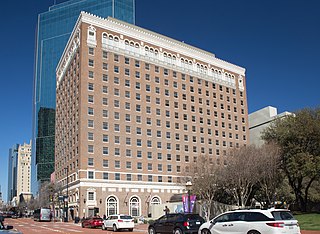
Hotel Adolphus is an upscale hotel in the Main Street District of Downtown Dallas Dallas, Texas. A Dallas Landmark, it was for several years the tallest building in the state. Today, the hotel is part of Marriott Hotel's Autograph Collection.

Dallas Union Station, officially Eddie Bernice Johnson Union Station, also known as Dallas Union Terminal, is a large intermodal railroad station in Dallas, Texas. It is the third busiest Amtrak station in Texas, behind Fort Worth Central Station and San Antonio station. It serves DART Light Rail Blue and Red lines, Trinity Railway Express commuter rail and Amtrak intercity rail. It is located on Houston Street, between Wood and Young Streets, in the Reunion district of Downtown Dallas. The structure is a Dallas Landmark and is listed on the National Register of Historic Places.

The Main Street District of downtown Dallas, Texas runs along Main Street and is bounded by Elm Street one block north, Commerce St. one block south, N. Lamar St. to the west, and US 75/I-45 (I-345) elevated highway to the east. The district is the spine of downtown Dallas, and connects many of the adjoining business and entertainment districts. It does not include Dealey Plaza or the John Fitzgerald Kennedy Memorial which are a few blocks west in the West End Historic District.

The Munger Place Historic District is a neighborhood and historic district in Old East Dallas, Texas (USA), generally lying between North Fitzhugh Avenue on the southwest, Gaston Avenue on the northwest, Henderson Avenue on the northeast, and Columbia Avenue on the southeast. Detailed boundaries are defined in the Munger Place Ordinance. It is a Dallas Landmark District and listed on the National Register of Historic Places.

The Plaza Hotel, formerly the Hilton Hotel, is a landmark skyscraper located at 106 Mills Avenue in El Paso, Texas, USA.

First Presbyterian Church of Dallas is a historic congregation at 1835 Young Street in the Farmers Market District of downtown Dallas, Texas (USA). The current building is a contributing property in the Harwood Street Historic District and a Dallas Landmark. The congregation was founded in 1856 as the first U.S. (Southern) Presbyterian Church organized in Dallas, and is the mother church from which many other Presbyterian churches in the area have stemmed.

The Kirby Building, historically known as the Busch Building, is a 17-story skyscraper in the Main Street District of Downtown Dallas. The structure was completed in 1913 by beer magnate Adolphus Busch to accompany his nearby Hotel Adolphus. The building became vacant with many older buildings during the economic downturn of the 1980s. While the building was symbolic of downtown's crash in the 1980s, it also served as a symbol of the start of the resurrection as it became the first high-rise to be converted from office use to residential apartments. The structure is a Dallas Landmark and listed on the National Register of Historic Places.

One Main Place is a mixed-use skyscraper hotel and office building at 1201 Main Street in Dallas, Texas. The building rises 445 ft (136 m). It contains 33 above-ground floors, and was completed in 1968. One Main Place currently stands as the 27th-tallest building in the city. The architectural firm that designed the building was Skidmore, Owings & Merrill, which also designed the Willis Tower and John Hancock Center in Chicago and the Burj Khalifa in Dubai. Gordon Bunshaft was the lead designer of One Main Place, and a few of his notable buildings include Lever House in New York, the Beinecke Rare Book and Manuscript Library at Yale University, and the Hirshhorn Museum and Sculpture Garden in Washington, DC. The building was listed on the National Register of Historic Places in 2015.

The Blackstone Hotel is the tallest hotel in downtown Fort Worth, Texas, at 268 ft (82 m) tall. Located on the corner of Fifth and Main Streets, it is noted for its Art Deco design with terracotta ornamentation and setbacks on the top floors. The hotel was constructed in 1929 and operated for over 50 years before it sat vacant for nearly 20 years. The Blackstone Hotel guest list is full of notable people including Presidents of the United States: Harry S. Truman, Dwight D. Eisenhower, John F. Kennedy, Lyndon B. Johnson, and Richard M. Nixon. The hotel was also host for a few movie stars such as Bob Hope, Clark Gable, and Elvis Presley. It was added to the National Register of Historic Places on February 2, 1984. The building was restored in the late 1990s and is still in use today as the Courtyard Fort Worth Downtown/Blackstone, although it is still known as the "Blackstone Hotel" to those who live in or have ties to Fort Worth.

The Tower Petroleum Building is a historic Art Deco Skyscraper located at 1907 Elm Street in the City Center District of Downtown Dallas. The tower, a contributing property in the Dallas Downtown Historic District and the Harwood Street Historic District, features Zig-zag Moderne styling and was designed by architect Mark Lemmon.

The Statler Hotel & Residences is a hotel of mid-twentieth century design located at 1914 Commerce Street in downtown Dallas, Texas (USA). It is located on the edge of the Farmers Market District and adjacent to Main Street Garden Park. The hotel opened in 1956 as The Statler Hilton and was praised as the first modern American hotel and was designed by William B. Tabler. Later renamed the Dallas Grand Hotel, it closed in 2001, then was restored and reopened in 2017. It is currently a member of Historic Hotels of America, the official program of the National Trust for Historic Preservation.

The Harwood Street Historic District is a historic commercial district and Dallas Landmark District on the east end of downtown Dallas, Texas lying in parts of the City Center District, Main Street District and Farmers Market District. The locally protected district generally encompasses structures in the blocks fronting Harwood Street from Pacific Avenue to Canton Street.

The Dallas Municipal Building is a Dallas Landmark located along S. Harwood Street between Main and Commerce Street in the Main Street District of downtown Dallas, Texas that served as the city's fourth City Hall. The structure is also a Recorded Texas Historic Landmark and a contributing property in the Harwood Street Historic District, located across the street from Main Street Garden Park.

Main Street Garden Park is a 1.75-acre (0.71 ha) public park located in downtown Dallas, Texas, United States The $17.4 million park was primarily funded through the City of Dallas’ 2003 and 2006 bond programs and is the first of several planned downtown core parks, including Pacific Plaza Park and Belo Garden Park. Main Street Garden replaced Pegasus Plaza as the site for major downtown events throughout the year.

The Santa Fe Terminal Complex is an 18-acre (73,000 m2) complex of historic buildings in the Government District of downtown Dallas, Texas (USA). Constructed in 1924 as the headquarters for the Gulf, Colorado and Santa Fe Railway and the Southwest's largest merchandising center, three of the original four buildings remain today and have been renovated into various uses. Santa Fe Buildings No. 1 and No. 2 were listed in the National Register of Historic Places in 1997, and the buildings are Dallas Landmarks. The Santa Fe Freight Terminal is regarded as one of the chief factors in the development of Dallas commercially.

The Dallas Scottish Rite Temple is a monumental structure in the Farmers Market District of downtown Dallas, Texas. Constructed in 1913 as an official headquarters for use by the Scottish Rite Masons and other local Masonic lodges, it is a fine example of early 20th century Beaux Arts Classical architecture in Texas. The structure, a Dallas Landmark and Recorded Texas Historic Landmark, is listed on the National Register of Historic Places and is a contributing property in the Harwood Street Historic District.

The former Dallas Public Library, now known as Old Dallas Central Library, is a multi-level civic structure located at 1954 Commerce Street in downtown Dallas, Texas (USA). It is located on the edge of the Farmers Market District and adjacent to Main Street Garden Park. It is a contributing property in the Dallas Downtown Historic District and the Harwood Street Historic District and, along with the adjacent Dallas Statler Hilton, represents the best block of mid-twentieth-century architecture in Dallas. It was part of Dallas Public Library.

Oak Lawn Methodist Episcopal Church, South is a historic United Methodist church at 3014 Oak Lawn Avenue in Dallas, Texas.

The Hilton Fort Worth is a historic hotel in downtown Fort Worth, Texas. Constructed from 1920 to 1921 as the Hotel Texas, it was designed by Sanguinet & Staats and Mauran, Russell, & Crowell, with Westlake Construction Co. as the contractor.

Historic Hotels of America is a program of the National Trust for Historic Preservation that was founded in 1989 with 32 charter members; the program accepts nominations and identifies hotels that have maintained their authenticity, sense of place, and architectural integrity. In 2015, the program included over 260 members in 44 states, including the District of Columbia, Puerto Rico, and the U.S. Virgin Islands. In 2022, the program includes 273 hotels. This article lists current and former member hotels.























